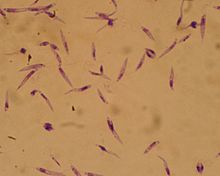| Leishmania major | |
|---|---|

| |
| Promastigotes of Leishmania major, 10×100, Giemsa stain. | |
| Scientific classification | |
| Domain: | Eukaryota |
| Phylum: | Euglenozoa |
| Class: | Kinetoplastea |
| Order: | Trypanosomatida |
| Genus: | Leishmania |
| Species: | L. major
|
| Binomial name | |
| Leishmania major Yakimoff and Schokhor, 1914
| |
Leishmania major is a species of parasite found in the genus Leishmania, and is associated with the disease zoonotic cutaneous leishmaniasis (also known as Aleppo boil, Baghdad boil, Bay sore, Biskra button, Chiclero ulcer, Delhi boil, Kandahar sore, Lahore sore, Oriental sore, Pian bois, and Uta).[1] L. major is an intracellular pathogen which infects the macrophages and dendritic cells of the immune system.[2] Though Leishmania species are found on every continent aside from Antarctica, Leishmania major is found only in the Eastern Hemisphere, specifically in Northern Africa,[3] the Middle East, Northwestern China, and Northwestern India.[4][5]
- ^ Abdulrahman A. Alrajhi; Elfaki A. Ibrahim; Edward B. De Vol; Mohammad Khairat; Rajab M. Faris; James H. Maguire (March 2002). "Fluconazole for the treatment of cutaneous leishmaniasis caused by Leishmania major". New England Journal of Medicine. 346 (12): 891–895. doi:10.1056/NEJMoa011882. PMID 11907288.
- ^ "Leishmania major". Wellcome Trust Sanger Institute, Genome Research Limited. Retrieved 6 December 2012.
- ^ Aoun, K.; Bouratbine, A. (2014). "Cutaneous Leishmaniasis in North Africa: a review". Parasite. 21: 14. doi:10.1051/parasite/2014014. PMC 3952656. PMID 24626301.
- ^ Markell, Edward K.; Voge, Marietta; John, David T. (1992). Medical Parasitology (7th ed.). W.B. Saunders. pp. 148–160. ISBN 0-7216-3411-7.
- ^ Cite error: The named reference
TIDwas invoked but never defined (see the help page).